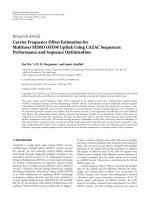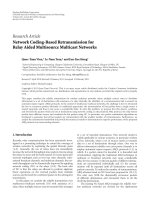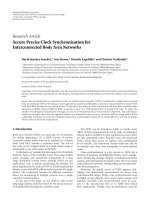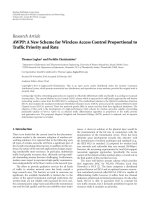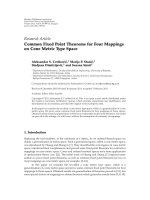Báo cáo hóa học: "Research Article Antiperiodic Boundary Value Problems for Finite Dimensional Differential Systems" pptx
Bạn đang xem bản rút gọn của tài liệu. Xem và tải ngay bản đầy đủ của tài liệu tại đây (501.07 KB, 11 trang )
Hindawi Publishing Corporation
Boundary Value Problems
Volume 2009, Article ID 541435, 11 pages
doi:10.1155/2009/541435
Research Article
Antiperiodic Boundary Value Problems for Finite
Dimensional Differential Systems
Y. Q. Chen,
1
D. O’Regan,
2
F. L. Wang,
1
and S. L. Zhou
1
1
Faculty of Applied Mathematics, Guangdong University of Technology, Guangzhou,
Guangdong 510006, China
2
Department of Mathematics, National University of Ireland, Galway, Ireland
Correspondence should be addressed to D. O’Regan,
Received 16 March 2009; Accepted 28 May 2009
Recommended by Juan J. Nieto
We study antiperiodic boundary value problems for semilinear differential and impulsive
differential equations in finite dimensional spaces. Several new existence results are obtained.
Copyright q 2009 Y. Q. Chen et al. This is an open access article distributed under the Creative
Commons Attribution License, which permits unrestricted use, distribution, and reproduction in
any medium, provided the original work is properly cited.
1. Introduction
The study of antiperiodic solutions for nonlinear evolution equations is closely related to
the study of periodic solutions, and it was initiated by Okochi 1. During the past twenty
years, antiperiodic problems have been extensively studied by many authors, see 1–31 and
the references therein. For example, antiperiodic trigonometric polynomials are important in
the study of interpolation problems 32, 33, and antiperiodic wavelets are discussed in 34.
Moreover, antiperiodic boundary conditions appear in physics in a variety of situations, see
35–40.InSection 2 we consider the antiperiodic problem
u
t
Au
t
f
t, u
t
,t∈ R,
u
t
−u
t T
,t∈ R,
E1.1
where A is an n × n matrix, f : R × R
n
→ R
n
is continuous, and ft T, x−ft, x for all
t, x ∈ R×R
n
. Under certain conditions on the nondiagonal elements of A and f we prove an
existence result for E1.1.InSection 3 we consider the antiperiodic boundary value problem
u
t
Gu
t
f
t, u
t
, a.e.t∈ J
0,T
,t
/
t
k
,
u
0
−u
T
,
Δu
t
k
I
k
u
t
k
,k 1, 2, ,p,
E1.2
2 Boundary Value Problems
where G : R
n
→ R
n
is a function satisfying G0 0, and f : J × R
n
→ R
n
is a Caratheodory
function, Δut
k
ut
k
− ut
−
k
,andI
k
∈ CR
n
,R
n
. Under certain conditions on G, f,and
I
k
u for k 1, 2, ,p, we prove an existence result for E1.2.
2. Antiperiodic Problem for Differential Equations in R
n
Let |·|be the norm in R
n
. In this section we study
u
t
Au
t
f
t, u
t
,t∈ R,
u
t
−u
t T
.
E2.1
First, we have the following result.
Theorem 2.1. Let A a
ij
be an n × n matrix, where a
ij
is the element of A in the ith row and jth
column, f : R → R
n
is continuous and ftT−ft for t ∈ R. Suppose T/2Σ
1≤i<j≤n
|a
ij
−a
ji
| <
1. Then the equation
u
t
Au
t
f
t
,t∈ R,
u
t
−u
t T
,t∈ R
E2.2
has a unique solution.
Proof. Put W
a
{v· ∈ CR; R
n
: vt−vt T}. Then W
a
is a Banach space under the
norm |v·|
∞
max
t∈0,T
|vt|. For each v· ∈ W
a
, consider the following equation:
u
t
Av
t
f
t
,t∈ R,
u
t
−u
t T
,t∈ R.
E2.3
It is easy to see that ut−1/2
T
0
Avsfsds
t
0
Avsfsds is the unique solution
of E2.3.
We define a mapping K : W
a
→ W
a
as follows:
for any v
·
∈ W
a
,Kv
·
u
·
,u
·
is the solution of
E2.3
. 2.1
First we prove that K is a continuous compact mapping. Now assume v
n
· ∈ W
a
, n 1, 2, ,
and v
n
· → v· ∈ W
a
. Then |Av
n
· − Av·|
∞
→ 0asn →∞. This immediately implies
that
T
0
|Kv
n
t
− Kvt
|
2
dt → 0asn →∞.
We have Kv
n
t − Kvt1/2{
t
0
Kv
n
s
− Kvs
ds −
T
t
Kv
n
s
−
Kvs
ds},andsoKv
n
· → Kv· in W
a
.
Now since Kvt
Avtft, t ∈ R,itiseasytoseethat
T
0
Kv
t
2
dt
1/2
≤
√
T|Av·|
∞
T
0
f
t
2
dt
1/2
. 2.2
Boundary Value Problems 3
Thus K maps a bounded subset of W
a
to a bounded equicontinuous subset in W
a
, therefore
K is completely continuous.
Next take r
0
> 1 − T/2Σ
1≤i<j≤n
|a
ij
− a
ji
|
−1
√
T/2
T
0
|ft|
2
dt
1/2
. We show that
Kv·
/
λv· for all λ ≥ 1, and |v·|
∞
r
0
. If this is not true, there exist λ
0
≥ 1, w· ∈ W
a
with
|w·|
∞
r
0
such that Kw·λ
0
w·,thatis,wt−wt T, t ∈ R and
λ
0
w
t
Aw
t
f
t
,t∈ R. 2.3
Multiply 2.3 by w
ti.e., take inner product and integrate over 0,T, and notice that
T
0
w
i
tw
j
tdt −
T
0
w
i
tw
j
tdt to get
λ
0
T
0
|w
t|
2
dt ≤ Σ
1≤i<j≤n
a
ij
− a
ji
T
0
w
i
t
w
j
t
dt
T
0
f
t
2
dt
1/2
T
0
w
t
2
dt
1/2
,
2.4
where wtw
i
t, i 1, 2, ,n.Noticethatwt1/2
t
0
w
sds −
T
t
w
sds,sowe
have
|w·|
∞
≤
√
T
2
T
0
w
t
2
dt
1/2
. 2.5
From 2.4, 2.5, we have
λ
0
T
0
w
t
2
dt
1/2
≤
√
TΣ
1≤i<j≤n
a
ij
− a
ji
|w·|
∞
T
0
f
t
2
dt
1/2
. 2.6
This with 2.5 gives
λ
0
|w·|
∞
≤
T
2
Σ
1≤i<j≤n
a
ij
− a
ji
|w·|
∞
√
T
2
T
0
f
t
2
dt
1/2
. 2.7
As a result
|w·|
∞
≤
1 −
T
2
Σ
1≤i<j≤n
a
ij
− a
ji
−1
√
T
2
T
0
f
t
2
dt
1/2
, 2.8
which contradicts |w·|
∞
r
0
.
Thus the Leray-Schauder degree degI − K, B0,r
0
, 01, where B0,r
0
is the open
ball centered at 0 with radius r
0
in C
a
. Consequently, K has a fixed point in B0,r
0
,thatis,
E2.2 has a solution. For the uniqueness, if u·,v· are two solutions of E2.2,setwt
ut − vt, then w
tAwt,andwt−wt T,fort ∈ R. Following the obvious
4 Boundary Value Problems
strategy above see the clear adjustment of 2.8 gives |w·|
∞
0. Thus the solution of
E2.2 is unique.
From Theorem 2.1 we have immediately the following result.
Corollary 2.2. Let A a
ij
be an n × n symmetric matrix, f : R → R
n
is continuous and
ft T−ft for t ∈ R.Then
u
t
Au
t
f
t
,t∈ R,
u
t
−u
t T
,t∈ R,
E2.4
has a unique solution.
Using a proof similar to Theorem 2.1, we have the following result.
Theorem 2.3. Let A a
ij
be an n ×n matrix, G : R
n
→ R
n
is an even continuously differentiable
function, and ft, u : R × R
n
→ R
n
is continuous and ft T, u−ft, u for t, u ∈ R × R
n
.
Suppose the following conditions are satisfied:
1 |ft, x|≤M|x| gt, for a.e. t, x ∈ R × R
n
,whereM>0 is a constant, and g· ∈
L
2
0,T;
2T/2Σ
1≤i<j≤n
|a
ij
− a
ji
| M < 1.
Then
u
t
Au
t
∂Gu
t
f
t, u
t
,t∈ R,
u
t
−u
t T
,t∈ R
E2.5
has a solution.
Remark 2.4. Equation E2.5 was studied by Haraux 18 and Chen et al. 14 in the case
A 0, and also by Chen 12 with different assumptions on f and A.
3. Antiperiodic Boundary Value Problem for Impulsive ODE
In this section, we prove an existence result for the equation
u
t
Gu
t
f
t, u
t
, a.e.t∈ J
0,T
,t
/
t
k
,
u
0
−u
T
,
Δu
t
k
I
k
u
t
k
,k 1, 2, ,p,
E3.1
where G : R
n
→ R
n
is a Lipschitz function. We first introduce some notations. Let
J 0,T,and0 t
0
<t
1
< ··· <t
p
<t
p1
T. PCJ{u : J → R
n
,u
t
k
,t
k1
∈
Ct
k
,t
k1
,R
n
,k 0, 1, ,p, ut
−
k
exist for k 1, 2, ,p,andu0
u0},and
PW
1,2
J{u ∈ PCJ : u
t
k
,t
k1
∈ W
1,2
t
k
,t
k1
,R
n
,k 1, ,p}. It is clear that PCJ
Boundary Value Problems 5
and PW
1,2
J are Banach spaces with the respective norm u
PCJ
sup{|ut|,t∈ J},and
u
PW
1,2
J
p
k0
u
k
W
1,2
t
k
,t
k1
, where u
k
: t
k
,t
k1
→ R is defined by u
k
tut for
t ∈ t
k
,t
k1
,k 0, 1, ,p.
We say a function u is a solution of E3.1 if u ∈ PW
1,2
J and u satisfies E3.1.
We first prove the following result.
Lemma 3.1. Let I
i
: R
n
→ R
n
be continuous functions for i 1, 2, ,p, and Σ
p
k1
|I
k
x
k
|≤
α{max
1≤k≤p
|x
k
|} δ for all x
k
∈ R
n
, k 1, 2, ,p,whereα, δ > 0 are constants, and α<2.
Suppose u ∈ PW
1,2
J with u0−uT, and Δut
i
I
i
ut
i
,fori 1, 2, ,p.Then
u
PCJ
≤
1 −
1
2
α
−1
⎡
⎣
1
2
δ
√
T
2
T
0
u
s
2
ds
1/2
⎤
⎦
. 3.1
Proof. By assumption, we have utu0
t
0
u
sds for t ∈ 0,t
1
,and
u
t
u
0
Σ
k
i1
I
i
u
t
i
t
0
u
s
ds 3.2
for t ∈ t
k
,t
k1
, k 1, 2, ,p. Since u0−uT, it follows that ut−1/2Σ
p
i1
I
i
ut
i
T
0
u
sds
t
0
u
sds for t ∈ 0,t
1
,and
u
t
−
1
2
Σ
p
i1
I
i
u
t
i
T
0
u
s
ds
Σ
k
i1
I
i
u
t
i
t
0
u
s
ds 3.3
for t ∈ t
k
,t
k1
, k 1, 2, ,p. Hence we have
u
PCJ
≤
1
2
αu
PC
J
δ
√
T
2
T
0
u
s
2
ds
1/2
. 3.4
Thus
u
PCJ
≤
1 −
1
2
α
−1
⎡
⎣
1
2
δ
√
T
2
T
0
u
s
2
ds
1/2
⎤
⎦
. 3.5
Theorem 3.2. Let G : R
n
→ R
n
be a function satisfying G0 0, and f : 0,T → R
n
such that
f· ∈ L
2
0,T, and let I
k
: R
n
→ R
n
be continuous functions for k 1, 2, ,p. Suppose the
following conditions are satisfied:
1 |Gu − Gv|≤L|u − v| for all u, v ∈ R
n
, and L>0 is a constant;
2Σ
p
k1
|I
k
x
k
|≤γ{max
1≤k≤p
|x
k
|} δ for all x
k
∈ R
n
, k 1, 2, ,p,whereγ,δ > 0 are
constants;
3 γ TL < 2.
6 Boundary Value Problems
Then the problem
u
t
Gu
t
f
t
, a.e.t∈ J
0,T
,t
/
t
k
,
u
0
−u
T
,
Δu
t
k
I
k
u
t
k
,k 1, 2, ,p
E3.2
has a solution.
Proof. For each v ∈ PCJ, consider the problem
u
t
Gv
t
f
t
a.e.t∈ J
0,T
,t
/
t
k
,
u
0
−u
T
,
Δu
t
k
I
k
v
t
k
,k 1, 2, ,p.
E3.3
One can easily show that the solution u of E3.3 is given by the following:
u
t
−
1
2
Σ
p
i1
I
i
v
t
i
T
0
Gv
s
f
s
ds
t
0
G
v
s
f
s
ds, for t ∈
0,t
1
,
u
t
−
1
2
Σ
p
i1
I
i
v
t
i
T
0
Gv
s
f
s
ds
Σ
k
i1
I
i
v
t
i
t
0
Gv
s
f
s
ds,
3.6
for t ∈ t
k
,t
k1
, k 1, ,p.
Obviously, the solution of E3.3 is unique. Now we define K : PCJ → PW
1,2
J ⊂
PCJ by u Kv. We prove that K is continuous. Let v
n
∈ PCJ and v
n
→ v in PCJ.Itis
easy to see that
T
0
Kv
n
t
− Kv
t
2
dt
T
0
|
Gv
n
t
− Gv
t
|
2
dt ≤ L
2
T
0
|v
n
t − vt|
2
dt. 3.7
Therefore
T
0
|Kv
n
t − Kvt
|
2
dt
1/2
≤
√
TLv
n
− v
PCJ
→ 0asn →∞.
Boundary Value Problems 7
Note that ΔKv
n
− Kvt
k
I
k
v
n
t
k
− I
k
vt
k
, and we have
Kv
n
t
− Kv
t
−
1
2
Σ
p
i1
I
i
v
n
t
i
− I
i
v
t
i
T
0
Kv
n
− Kv
s
ds
t
0
Kv
n
− Kv
s
ds, for t ∈
0,t
1
,
Kv
n
t
− Kv
t
−
1
2
Σ
p
i1
I
i
v
n
t
i
− I
i
v
t
i
T
0
Kv
n
− Kv
s
ds
Σ
k
i1
I
i
v
n
t
i
− I
i
v
t
i
t
0
Kv
n
− Kv
s
ds
3.8
for t ∈ t
k
,t
k1
, k 1, 2, ,p. From the continuity of I
i
, i 1, 2, ,p,and
T
0
|Kv
n
t −
Kvt
|
2
dt → 0asn →∞, we deduce that K is continuous.
For each v ∈ PCJ,noticethat0 G0, so we have
T
0
|
Kv
|
2
dt
1/2
≤
√
TLv
PCJ
T
0
f
s
2
ds
1/2
. 3.9
From 3.9 and Lemma 3.1,weknowthatK maps bounded subsets of PCJ to relatively
compact subsets of PCJ.
Finally, for ∀λ ∈ 0, 1, we prove that the set of solutions of u λKu is bounded. If
u λKu for some λ ∈ 0, 1, then
u
t
λGu
t
λf
t
a.e.t∈ J
0,T
,t
/
t
k
,
u
0
−u
T
,
Δu
t
k
λI
k
u
t
k
,k 1, 2, ,p.
3.10
Therefore we have
u
t
−
1
2
λ
Σ
p
i1
I
i
u
i
t
i
T
0
Gu
s
f
s
ds
λ
t
0
G
u
s
f
s
ds 3.11
for t ∈ 0,t
1
,and
u
t
−
1
2
λ
Σ
p
i1
I
i
u
i
t
i
T
0
Gu
s
f
s
ds
λ Σ
k
i1
I
i
u
i
t
i
λ
t
0
G
u
s
f
s
ds
3.12
8 Boundary Value Problems
for t ∈ t
k
,t
k1
, k 1, ,p. This implies that
u
PCJ
≤
1
2
γu
PC
J
δ
T
0
|
Gu
s
|
f
s
ds
. 3.13
Since 0 G0, and |Gu|≤L|u|, so we have
u
PCJ
≤
1
2
1 −
1
2
γ TL
−1
δ
T
0
f
s
ds
. 3.14
The Leray-Schauder principle guarantees a fixed point of K, which is easily seen to be a
solution of E3.2.
By using a similar method to Theorem 3.2, one can deduce the following result.
Theorem 3.3. Let G : R
n
→ R
n
be a function satisfying G0 0, and ft, x : 0,T × R
n
→ R
n
a Caratheodory function, that is, f is measurable in t for each x ∈ R
n
, and f is continuous in x for
each t ∈ 0,T, such that |ft, x|≤gt for t, x ∈ 0,T × R
n
,whereg· ∈ L
2
0,T, and
let I
k
: R
n
→ R
n
be continuous functions for k 1, 2, ,p. Suppose the following conditions are
satisfied:
1 |Gu − Gv|≤L|u − v| for all u, v ∈ R
n
, and L>0 is a constant;
2Σ
p
k1
|I
k
x
k
|≤γ{max
1≤k≤p
|x
k
|} δ for all x
k
∈ R
n
, k 1, 2, ,p,whereγ,δ > 0 are
constants;
3 γ TL < 2.
Then the equation
u
t
Gu
t
f
t, u
t
, a.e.t∈ J
0,T
,t
/
t
k
,
u
0
−u
T
,
Δu
t
k
I
k
u
t
k
,k 1, 2, ,p
E3.4
has a solution.
4. Examples
In this section, we give examples to show the application of our results to differential and
impulsive differential equations.
Boundary Value Problems 9
Example 4.1. Consider the antiperiodic problem
u
1
t
λ
1
u
1
t
5u
2
t
sin πt, t ∈ R,
u
2
t
7
2
u
1
t
λ
2
u
2
t
cos πt, t ∈ R,
u
1
t
−u
1
t 1
,u
2
t
−u
2
t 1
,t∈ R.
E4.1
Set
u
u
1
u
2
,f
t
sin πt
cos πt
,A
⎛
⎝
λ
1
5
7
2
λ
2
⎞
⎠
. 4.1
Now E4.1 is equivalent to
u
t
Au
t
f
t
,t∈ R,
u
t
−u
t 1
,t∈ R.
E4.2
Also ft−ft 1,fort ∈ R and 1/2|a
12
−a
21
| 3/4. By Theorem 2.1, E4.2 has a unique
solution, so E4.1 has a unique solution.
Example 4.2. Consider the antiperiodic boundary value problem
u
1
t
1
2 u
2
1
t
u
2
2
t
3u
1
t
− 2u
2
t
sin πt, t ∈
0, 1
,t
/
1
4
,
u
2
t
1
2 u
2
1
t
u
2
2
t
2u
1
t
3u
2
t
− cos πt, t ∈
0, 1
,t
/
1
4
,
Δu
1
1
4
1
5
1
|
u
2
1/4
|
, Δu
2
1
4
1
8
1
|
u
1
1/4
|
,
u
1
0
−u
1
1
,u
2
0
−u
2
1
.
E4.3
Set
u
u
1
u
2
,f
t
sin πt
−cos πt
,Gu
⎛
⎜
⎜
⎝
3u
1
− 2u
2
2 u
2
1
u
2
2
2u
1
3u
2
2 u
2
1
u
2
2
⎞
⎟
⎟
⎠
,I
u
⎛
⎜
⎜
⎝
1
5
1
|
u
2
|
1
8
1
|
u
1
|
⎞
⎟
⎟
⎠
.
4.2
10 Boundary Value Problems
It is easy to check that |Gu − Gv|≤
√
13/2|u − v| for u, v ∈ R
2
, |Iu| < 2/5foru ∈ R
2
,and
√
13/2 < 2. Now E4.3 is equivalent to the equation
u
t
Gu
t
f
t
,t∈
0, 1
,t
/
1
4
,
Δu
1
4
I
u
1
4
,u
0
−u
1
.
E4.4
By Theorem 3.2, we know that E4.4 has a solution, so E4.3 has a solution.
Acknowledgment
The first author is supported by an NSFC Grant, Grant no. 10871052.
References
1 H. Okochi, “On the existence of periodic solutions to nonlinear abstract parabolic equations,” Journal
of the Mathematical Society of Japan, vol. 40, no. 3, pp. 541–553, 1988.
2 A. R. Aftabizadeh, S. Aizicovici, and N. H. Pavel, “On a class of second-order anti-periodic boundary
value problems,” Journal of Mathematical Analysis and Applications, vol. 171, no. 2, pp. 301–320, 1992.
3 A. R. Aftabizadeh, S. Aizicovici, and N. H. Pavel, “Anti-periodic boundary value problems for higher
order differential equations in Hilbert spaces,” Nonlinear Analysis: Theory, Methods & Applications,vol.
18, no. 3, pp. 253–267, 1992.
4 B. Ahmad and V. Otero-Espinar, “Existence of solutions for fractional differential inclusions with anti-
periodic boundary conditions,” Boundary Value Problems, vol. 2009, Article ID 625347, 11 pages, 2009.
5 B. Ahmad and J. J. Nieto, “Existence and approximation of solutions for a class of nonlinear impulsive
functional differential equations with anti-periodic boundary conditions,” Nonlinear Analysis: Theory,
Methods & Applications, vol. 69, no. 10, pp. 3291–3298, 2008.
6 S. Aizicovici and N. H. Pavel, “Anti-periodic solutions to a class of nonlinear differential equations in
Hilbert space,” Journal of Functional Analysis, vol. 99, no. 2, pp. 387–408, 1991.
7 A. Cabada and D. R. Vivero, “Existence and uniqueness of solutions of higher-order antiperiodic
dynamic equations,” Advances in Difference Equations, vol. 2004, no. 4, pp. 291–310, 2004.
8 Y. Q. Chen, “Note on Massera’s theorem on anti-periodic solution,” Advances in Mathematical Sciences
and Applications, vol. 9, pp. 125–128, 1999.
9 Y. Q. Chen, X. Wang, and H. Xu, “Anti-periodic solutions for semilinear evolution equations,” Journal
of Mathematical Analysis and Applications, vol. 273, no. 2, pp. 627–636, 2002.
10 Y. Q. Chen, Y. J. Cho, and J. S. Jung, “Antiperiodic solutions for semilinear evolution equations,”
Mathematical and Computer Modelling, vol. 40, no. 9-10, pp. 1123–1130, 2004.
11 Y. Q. Chen, Y. J. Cho, and D. O’Regan, “Anti-periodic solutions for evolution equations with
mappings in the class S
,” Mathematische Nachrichten, vol. 278, no. 4, pp. 356–362, 2005.
12 Y. Q. Chen, “Anti-periodic solutions for semilinear evolution equations,” Journal of Mathematical
Analysis and Applications, vol. 315, no. 1, pp. 337–348, 2006.
13 Y. Q. Chen, Y. J. Cho, and F. L. Wang, “Anti-periodic boundary value problems for impulsive
differential equations,” International Journal of Computational and Applied Mathematics, vol. 1, pp. 9–
16, 2006.
14 Y. Q. Chen, J. J. Nieto, and D. O’Regan, “Anti-periodic solutions for fully nonlinear first-order
differential equations,” Mathematical and Computer Modelling, vol. 46, no. 9-10, pp. 1183–1190, 2007.
15 D. Franco and J. J. Nieto, “First-order impulsive ordinary differential equations with anti-periodic
and nonlinear boundary conditions,” Nonlinear Analysis: Theory, Methods & Applications, vol. 42, no. 2,
pp. 163–173, 2000.
16 D. Franco, J. J. Nieto, and D. O’Regan, “Anti-periodic boundary value problem for nonlinear first
order ordinary differential equations,” Mathematical Inequalities and Applications, vol. 6, no. 3, pp. 477–
485, 2003.
Boundary Value Problems 11
17 D. Franco, J. J. Nieto, and D. O’Regan, “Existence of solutions for first order ordinary differential
equations with nonlinear boundary conditions,” Applied Mathematics and Computation, vol. 153, no. 3,
pp. 793–802, 2004.
18 A. Haraux, “Anti-periodic solutions of some nonlinear evolution equations,” Manuscripta Mathemat-
ica, vol. 63, no. 4, pp. 479–505, 1989.
19 Y. Li and L. Huang, “Anti-periodic solutions for a class of Li
´
enard-type systems with continuously
distributed delays,” Nonlinear Analysis: Real World Applications, vol. 10, no. 1, pp. 2127–2132, 2009.
20 B. Liu, “An anti-periodic LaSalle oscillation theorem for a class of functional differential equations,”
Journal of Computational and Applied Mathematics, vol. 223, no. 2, pp. 1081–1086, 2009.
21 B. Liu, “Anti-periodic solutions for forced Rayleigh-type equations,” Nonlinear Analysis: Real World
Applications, vol. 10, no. 5, pp. 2850–2856, 2009.
22 Z. Luo, J. Shen, and J. J. Nieto, “Antiperiodic boundary value problem for first-order impulsive
ordinary differential equations,” Computers and Mathematics with Applications, vol. 49, no. 2-3, pp. 253–
261, 2005.
23 M. Nakao, “Existence of an anti-periodic solution for the quasilinear wave equation with viscosity,”
Journal of Mathematical Analysis and Applications, vol. 204, no. 3, pp. 754–764, 1996.
24 H. Okochi, “On the existence of anti-periodic solutions to a nonlinear evolution equation associated
with odd subdifferential operators,” Journal of Functional Analysis, vol. 91, no. 2, pp. 246–258, 1990.
25 H. Okochi, “On the existence of anti-periodic solutions to nonlinear parabolic equations in
noncylindrical domains,” Nonlinear Analysis: Theory, Methods & Applications, vol. 14, no. 9, pp. 771–
783, 1990.
26 P. Souplet, “Uniqueness and nonuniqueness results for the antiperiodic solutions of some second-
order nonlinear evolution equations,” Nonlinear Analysis: Theory, Methods & Applications, vol. 26, no.
9, pp. 1511–1525, 1996.
27 P. Souplet, “Optimal uniqueness condition for the antiperiodic solutions of some nonlinear parabolic
equations,” Nonlinear Analysis: Theory, Methods & Applications, vol. 32, no. 2, pp. 279–286, 1998.
28 K. Wang, “A new existence result for nonlinear first-order anti-periodic boundary value problems,”
Applied Mathematics Letters, vol. 21, no. 11, pp. 1149–1154, 2008.
29 K. Wang and Y. Li, “A note on existence of anti-
periodic and heteroclinic solutions for a class of
second-order odes,” Nonlinear Analysis: Theory, Methods & Applications, vol. 70, no. 4, pp. 1711–1724,
2009.
30 R. Wu, “An anti-periodic LaSalle oscillation theorem,” Applied Mathematics Letters, vol. 21, no. 9, pp.
928–933, 2008.
31 Y. Yin, “Monotone iterative technique and quasilinearization for some anti-periodic problem,”
Nonlinear World, vol. 3, pp. 253–266, 1996.
32 F J. Delvos and L. Knoche, “Lacunary interpolation by antiperiodic trigonometric polynomials,” BIT
Numerical Mathematics, vol. 39, no. 3, pp. 439–450, 1999.
33 J. Du, H. Han, and G. Jin, “On trigonometric and paratrigonometric Hermite interpolation,” Journal
of Approximation Theory, vol. 131, no. 1, pp. 74–99, 2004.
34 H. L. Chen, “Antiperiodic wavelets,” Journal of Computational Mathematics, vol. 14, no. 1, pp. 32–39,
1996.
35 A. Abdurrahman, F. Anton, and J. Bordes, “Half-string oscillator approach to string field theory
ghost sector I,” Nuclear Physics B, vol. 397, no. 1-2, pp. 260–282, 1993.
36 C. Ahn and C. Rim, “Boundary flows in general coset theories,” Journal of Physics A, vol. 32, no. 13,
pp. 2509–2525, 1999.
37 Y. Li and L. Yang, “Anti-periodic solutions for Cohen-Grossberg neural networks with bounded and
unbounded delays,” Communications in Nonlinear Science and Numerical Simulation, vol. 14, no. 7, pp.
3134–3140, 2009.
38 M. Pawellek, “Quantization of sine-Gordon solitons on the circle: semiclassical vs. exact results,”
Nuclear Physics B, vol. 810, no. 3, pp. 527–541, 2009.
39 S. Pinsky and U. Trittmann, “Antiperiodic boundary conditions in supersymmetric discrete light cone
quantization,” Physical Review D, vol. 62, no. 8, Article ID 087701, 4 pages, 2000.
40 J. Shao, “Anti-periodic solutions for shunting inhibitory cellular neural networks with time-varying
delays,” Physics Letters A, vol. 372, no. 30, pp. 5011–5016, 2008.
